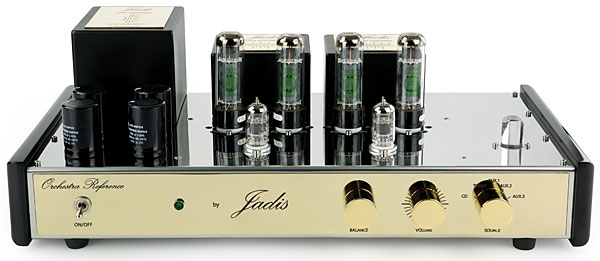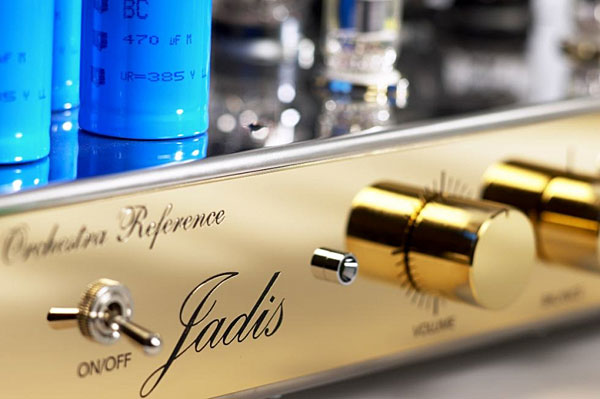| Columns Retired Columns & Blogs |
Jadis Orchestra Reference Mk.II integrated amplifier

I don't think Americans dislike the French a tenth as much as the corporate media, in their endless struggle to sell our pettiest ideas back to us in cartoon form, suggests we do. Our nations' histories are intertwined, to our great mutual benefit. Americans envy the French their centuries of cultural accomplishments, the French envy Americans their sense of industry and their wide-open spaces. (That one's a tie.) We turn to them for wine, they turn to us for blue jeans. (A point for France.) We watch their films about law-breaking hipsters, they watch our films about law-breaking gangsters. (A point for the US, in whose films things actually happen.)
Footnote 1: Readers interested in the psychology of audio reviewing—I do not sneer as I write this—should note that I didn't learn of the Orchestra Reference Mk.II's active, solid-state front end until well after making all of my listening notes. Needless to say, I altered none of my subjective observations to fit that newfound fact, but I did remove one comment that said, in effect, "I was surprised to hear such a good sense of drive from an integrated amp with a passive front end," because that observation now seemed pretty stupid.
And we appear to love each other's audio gear. French audiophiles have welcomed into their homes a good many Wilson Audio loudspeakers, VPI turntables, and Ayre Acoustics amplifiers, while we have imported our share of Focal and Triangle speakers and Jadis amps—the last being of special interest to me, given their reliance on the Holy Binity of tubes and transformers.
So it was in the fall of 2013 that I leaped at an opportunity to write about the then-new Jadis I-35, a 30Wpc integrated amplifier ($7995)1 that sounded sunny and graceful in my system, which favors amps of modest power. Two years later, I was offered the chance to write about a different Jadis integrated: the considerably less expensive Orchestra Reference Mk.II ($4795). As our brothers in culture and commerce would say, Pourquoi diable ne pas?
Description
The Orchestra Reference Mk.II is the latest version of an integrated amp that has been a Jadis mainstay since the late 1990s. It uses a total of six tubes: two contemporary, Russian-made Tung-Sol 12AX7 small-signal dual triodes, and four similarly Russian Electro-Harmonix EL34 pentodes. When I first took note of its scant number of small-signal tubes, I simply assumed that the Orchestra Reference Mk.II is among those contemporary integrated amps built around a passive rather than an active preamp stage. My assumption was indeed simple: As it turns out, this Jadis is a hybrid, with a pair of bipolar transistors to supply gain ahead of the amp's tubed driver stage (footnote 1), which employs one 12AX7 per channel in what Jadis describes as a cathode-driver circuit.

Jadis claims that each channel's push-pull pair of EL34 tubes produces 40W in class-AB, with a small amount of global feedback, and with the tubes working in fixed-bias mode, their cathodes at ground. The bias current is not user adjustable; each tube has its own miniature trim pot for that purpose, but those pots can be accessed only by removing the bottom plate: a chore and a half. As shipped from Jadis, the Orchestra's individually boxed output tubes are marked for their specific sockets, sparing the need to recalibrate the amp when it is first installed in one's system.
As in all Jadis amplifiers, the Orchestra Reference Mk.II's output transformers are designed and wound in-house, then encased in resin before being wrapped in paper and something very like shellac. These transformers are wound for Ultralinear configuration: with a tapped primary for connection to the EL34s' screen grids. (A brief look inside the amp confirmed that the plate and screen grid of each output tube are connected to separate terminals on the primary of that channel's output transformer.) That said, Jadis describes this amplifier's output section as combining the electrical characteristics of both Ultralinear and triode configurations. Strictly speaking, the latter requires the screen grid of an output pentode to be connected directly to its plate, so I assume that Jadis means that the primaries of their output transformers have their taps nearer than usual to the plate end of that coil. But that's only a guess—Jadis guards the specifics of this design as proprietary.
The amplifier is built into a stainless-steel chassis of slightly unusual size: At 20.7" wide by 7.8" high by 10.5" deep, the Orchestra Reference has the proportions of a stretch limo, occupying considerable width but little enough depth that something else—a small phono preamp, perhaps?—could sit in front of it on the same shelf. Its outer surfaces are polished to a chrome-like finish, and a nice-looking, black-enameled tube cage, 10" wide by 5" high by 5" deep, protects the zookeeper from the animals and vice versa. The Orchestra Reference adheres to Jadis's usual style of setting against a silver-colored background a gold-colored faceplate and matching knobs for volume, source selection, and—hallelujah!—channel balance. As an option, remote control is offered ($350), but I asked Jadis not to send me a handset, because I prefer thrift over extravagance, and because I have about as much use for a remote as I do for a six-motor La-Z-Boy massage recliner with heat.
My sample of the Orchestra Reference Mk.II was as beautifully built as the somewhat more expensive Jadis I-35 I reviewed in the January 2014 issue. Apart from three small circuit boards—one for a portion of the power supply, one to which the input jacks and input selector are fastened, and one that contains the solid-state gain stage and the signal traces for the volume and balance controls—the amp is hand-wired, point-to point. The layout is sensible, the wiring and soldering are impeccably done, and the parts quality ranges from very good to superb.
Installation and setup
Shipping and packing materials for the Orchestra Reference Mk.II were of decent quality—it arrived in apparently flawless shape. The instruction manual includes a guide to installing the six tubes: For shipping, they're removed from their sockets and packed inside the tube cage, which must itself be removed from the case using a supplied Allen wrench. Each Orchestra Reference also comes with a signed fiche de controle finale (ie, final quality-control card); mine was signed by J.C. Calmettes, chief designer and son of Jadis's founder, André Calmettes. An AC cord is supplied; I didn't experiment with aftermarket replacements.
On the Orchestra Reference's rear panel are five pairs of single-ended (RCA) line-level inputs, plus a sixth pair of RCA jacks carrying the preamp-out signal. Only one pair of five-way speaker connectors is provided; as on the Jadis I-35 integrated amplifier I reviewed, these connectors are not labeled Left and Right, nor is this information provided in the otherwise fine manual. As it turned out, the left-channel connectors are on the left side of the panel when the amp is viewed from the front.
Footnote 1: Readers interested in the psychology of audio reviewing—I do not sneer as I write this—should note that I didn't learn of the Orchestra Reference Mk.II's active, solid-state front end until well after making all of my listening notes. Needless to say, I altered none of my subjective observations to fit that newfound fact, but I did remove one comment that said, in effect, "I was surprised to hear such a good sense of drive from an integrated amp with a passive front end," because that observation now seemed pretty stupid.
- Log in or register to post comments




































